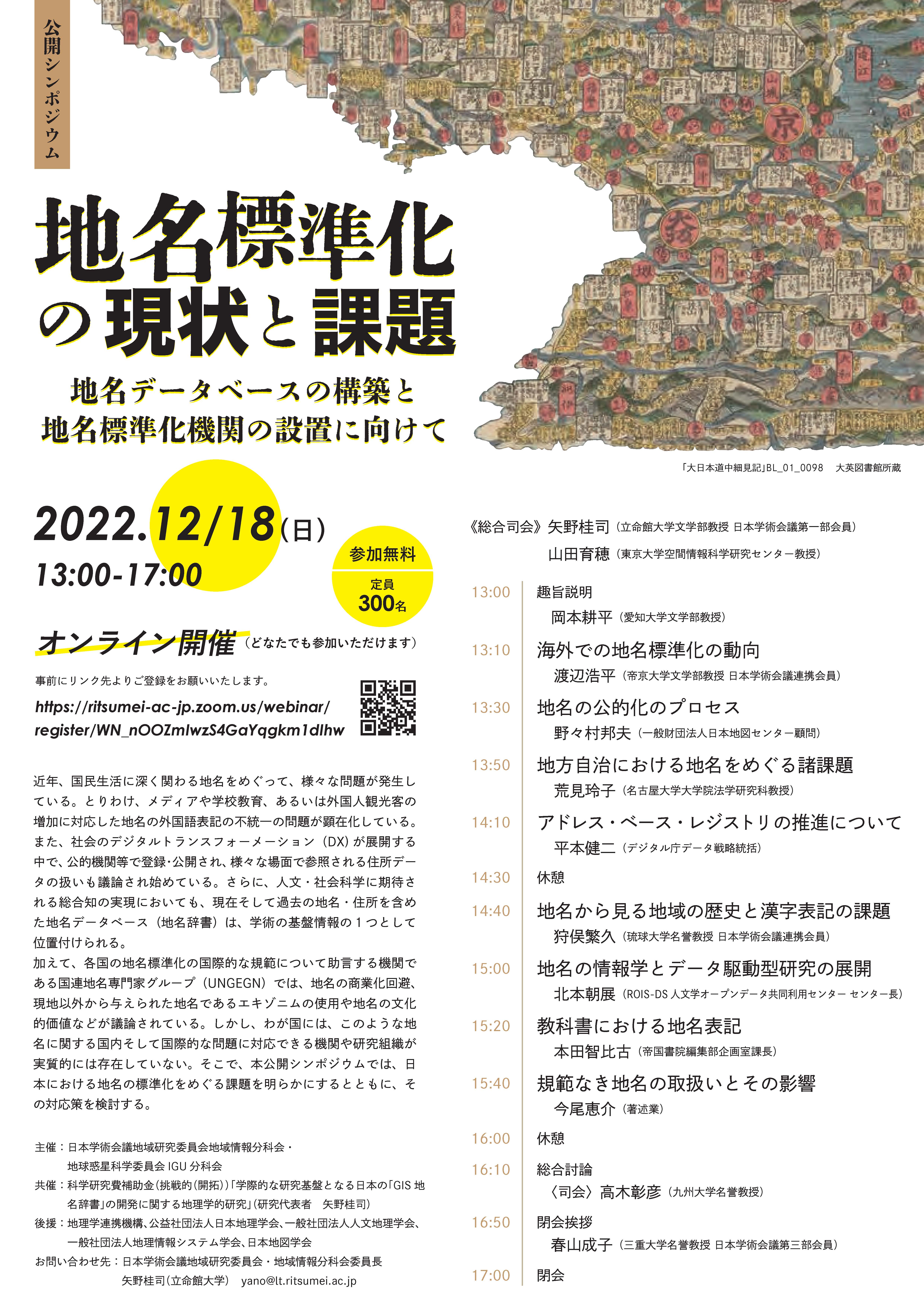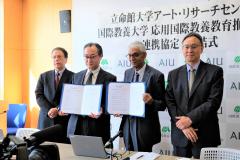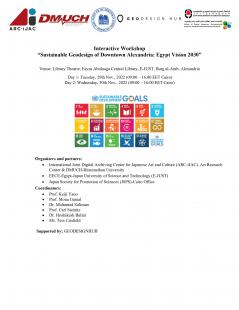-
 10
11
12
13
14
15
16
17
18
19
20
10
11
12
13
14
15
16
17
18
19
20

 With the establishment of the International Joint Digital Archiving Center for Japanese Art and Culture (ARC-iJAC) in 2019, the Art Research Center strives to push the internationalization of research activities that transcend disciplines and geographic boundaries.
With the establishment of the International Joint Digital Archiving Center for Japanese Art and Culture (ARC-iJAC) in 2019, the Art Research Center strives to push the internationalization of research activities that transcend disciplines and geographic boundaries.NEWS
 Keynote speech by Prof. Hans B. Thomsen (University of Zurich) on Academia and Museums: The Importance of Collaborative Projects.
Keynote speech by Prof. Hans B. Thomsen (University of Zurich) on Academia and Museums: The Importance of Collaborative Projects.
>>Program & Registration

 We were delighted to welcome Her Imperial Highness Princess Akiko of Mikasa, and Professor Emeritus Henry Smith (Columbia University) to the ARC.
We were delighted to welcome Her Imperial Highness Princess Akiko of Mikasa, and Professor Emeritus Henry Smith (Columbia University) to the ARC.
HIH Princess Akiko of Mikasa was previously a postdoctoral researcher at the ARC while Professor Emeritus Henry Smith is a member of the ARC-iJAC External Evaluation Committee. ARC-iJAC Project Spotlights: An Interview with Kelly Midori McCormick (University of British Columbia) and Carrie Cushman (Hartford Art School)Supported by the ARC-iJAC, a team led by Dr. Kelly Midori McCormick and Dr. Carrie Cushman has been conducting research under the theme Expanding the Study of Japanese Photography and Gender: Modules for Teaching and Public Access.
ARC-iJAC Project Spotlights: An Interview with Kelly Midori McCormick (University of British Columbia) and Carrie Cushman (Hartford Art School)Supported by the ARC-iJAC, a team led by Dr. Kelly Midori McCormick and Dr. Carrie Cushman has been conducting research under the theme Expanding the Study of Japanese Photography and Gender: Modules for Teaching and Public Access.
Resulting from this, they have launched the bilingual website Behind the Camera--part database, part educational tool--spotlighting a diverse range of international experts on the history of Japanese photography from the perspective of gender and power.
>>Read full interview.This project is actively seeking contributors in Japan and around the world for new modules on the history of Japanese photography from new perspectives. If you have a proposal for a module, please reach out. 
On November 28, 2022, a signing ceremony for the MoU was held at Akita International University. The MoU provides a stable framework to advance collaborative projects in digital humanities, such as integrating AIU's Akita Folkloric Performance Art Archives with audiovisual records of more than 300 folkloric performance arts in the ARC Portal Database System. >>Read full article.

In November 2022, we were pleased to welcome Prof. Adam Habib to the ARC where he discussed the possibility of establishing a partnership in digital humanities with Prof. Ryo Akama. >>Read full article.  Supported by the ARC, the Japan Foundation Kyoto Office organizes the annual event to provide an opportunity to experience traditional Japanese culture. The performances, filmed by the ARC, are available online for a year.
Supported by the ARC, the Japan Foundation Kyoto Office organizes the annual event to provide an opportunity to experience traditional Japanese culture. The performances, filmed by the ARC, are available online for a year.Upcoming Events
January 28 (Sat), 2023, 16:00-18:00 JST
International Online Symposium
Topic: Tracing the Reception of Japanese Art in the West: As Seen through Case Studies in Central Europe
<<Program & Registration>>
<<Flyer>>


January 31 (Tue), 2023, 9:50-18:00 JST
Graduate Student Colloquium
Topic: Arts and Culture Studies of East Asia in the Post-Media Era: Themes and Perspectives
<<Zoom URL>>
(no registration required)




Previous issues:
Autumn 2022, Summer 2022, Spring 2022, Winter 2021, Autumn 2021, Summer 2021, Spring 2021, Winter 2020, Autumn 2020, Summer 2020, Spring 2020view this email in your browser Copyright © 2023 Art Research Center, Ritsumeikan University. All rights reserved.
Our mailing address is:
56-1 Toji-in Kitamachi, Kita-ku, Kyoto 603-8577 JAPAN
Want to change how you receive these emails?
You can update your preferences or unsubscribe from this list.紀要『アート・リサーチ』24号の原稿募集を開始しました
本紀要は、アート・リサーチセンターで展開する各研究プロジェクトの活動成果を広く公開する目的を持つとともに、芸術文化を専門とした学術雑誌として、例年多くの方にご投稿いただいております。
アート・リサーチセンターは、1998年度設立以来、文化・芸術・情報科学に関する優れた研究拠点として、国の複数の補助金に採択され、2019年度には文部科学省「国際共同利用・共同研究拠点」として認定されるなど、研究を一層深化させています。また、文化芸術のデジタルアーカイブにおける先端的拠点としても、高く評価されています。オンラインジャーナルとして年複数回発行し、年度末には、それらをまとめた冊子も発行します。
続きを読む>>
原稿募集は随時行っております。
投稿機会の自由度が大幅に高まりますので、是非とも積極的なご応募をお待ちしております。2023年1月18日(水)18:00より、Web配信にて第114回国際ARCセミナーを開催いたします。
プログラムは下記となります。
1.
講師:安宅望氏 (立命館大学大学院 文学研究科 博士課程後期課程)タイトル:「近世後期における奈良の寺社の実相」-奈良奉行川路聖謨の日記『寧府紀事』から見えてくるもの
2.
講師:戸塚史織氏 (立命館大学大学院 文学研究科 博士課程後期課程)タイトル:「勝川派の浮世絵作品にみられる改印の問題」
日時:2023年1月18日(水)18:00~19:30
参加:Zoom配信(関係者のみ・予約不要)
※ARCメンバー以外の方は Youtubeよりご参加いただけます。こちらからご覧下さい。
[イベント情報]2022年12月26日(月)ARC-iJACでは、2023年度に本拠点から研究に必要な経費の配分を受けて共同研究を行う、国際共同研究課題〔研究費配分型〕を公募しています。申請締切は2023年1月20日(金)午後17時です。
国際共同研究課題〔研究費配分型〕の公募要項・申請書はこちら
続きを読む>>立命館大学アート・リサーチセンターの矢野桂司教授(文学部)が総合司会を務める公開シンポジウム「地名標準化の現状と課題:地名データベースの構築と地名標準化機関の設置に向けて」が開催されます。
開催日時:2022年12月18日(日)13:00-17:00
開催方法:オンライン
対象 :どなたでもご参加いただけます(要申込)詳細 >>「地名標準化の現状と課題:地名データベースの構築と地名標準化機関の設置に向けて」
申込 >>申込フォーム
2022年11月28日、立命館大学アート・リサーチセンター(ARC)は、公立大学法人国際教養大学(AIU)応用国際教養教育推進機構と、学術研究交流に関する連携協定を締結いたしました。
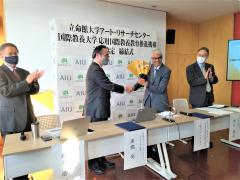 国際教養大学で行われた協定締結式には、国際教養大学からは、モンテ・カセム学長、熊谷嘉隆副学長が出席され、アート・リサーチセンターからは、赤間亮センター長(文学部)、細井浩一副センター長(映像学部)が出席しました。カセム学長は、立命館アジア太平洋大学(APU)の学長および学校法人立命館副総長を歴任された方で、今回の連携協定を実現するために中心的な役割を果たしてくださいました。
国際教養大学で行われた協定締結式には、国際教養大学からは、モンテ・カセム学長、熊谷嘉隆副学長が出席され、アート・リサーチセンターからは、赤間亮センター長(文学部)、細井浩一副センター長(映像学部)が出席しました。カセム学長は、立命館アジア太平洋大学(APU)の学長および学校法人立命館副総長を歴任された方で、今回の連携協定を実現するために中心的な役割を果たしてくださいました。この連携協定締結により、秋田県内の300以上の民俗芸能を収録・公開しているAIUの「秋田民俗芸能アーカイブス」が、日本文化・芸術のデジタル・アーカイブでは最大規模の研究活動を行っているアート・リサーチセンターのARCポータルデータベースシステムと連携することになります。
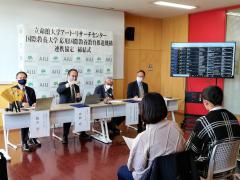 これにより、「秋田民俗芸能アーカイブス」のアクセス数の増加が見込まれ、その結果、民俗芸能の映像資料等の活用が世界的に促進されるだけでなく、秋田の民俗芸能の継承に寄与することも期待できます。
これにより、「秋田民俗芸能アーカイブス」のアクセス数の増加が見込まれ、その結果、民俗芸能の映像資料等の活用が世界的に促進されるだけでなく、秋田の民俗芸能の継承に寄与することも期待できます。今後は、共同研究プログラムの組織・参加、両機関の研究者の交流を模索し、双方の学術研究を強化していく予定です。
締結式に続いて行われた座談会では、熊谷教授が「秋田民俗芸能アーカイブス」を紹介され、赤間教授が、同アーカイブスとARCポータルデータベースシステムとの連携について説明されました。その後、双方の参加者4名全員よりARCとAIUの文化継承に対する思いについて、座談会形式で話し合われました。
国際教養大学(AIU)公式サイト:https://www.aiu.ac.jp
秋田民俗芸能アーカイブス: https://www.akita-minzoku-geino.jp/archives/ja/
立命館大学アート・リサーチセンター(ARC)データベース:https://www.arc.ritsumei.ac.jp/j/database/
[イベント情報]2022年11月29日(火)インタラクティブなワークショップ「Sustainable Geodesign of Downtown Alexandria: Egypt Vision 2030」が アート・リサーチセンター 国際共同利用・共同研究拠点「日本文化資源デジタル・アーカイブ国際共同研究拠点」(ARC-iJAC)共催のもと開催されます。
開催場所:Library Theatre, Fayza Abulnaga Central Library, E-JUST, Burg al-Arab, Alexandria
1日目 : 2022年11月29日(火)(9:00 - 16:00 EET Cairo / 16:00 - 23:00 JST)
2日目 : 2022年11月30日(水)(9:00 - 16:00 EET Cairo / 16:00 - 23:00 JST)参加希望の方は、r-darc@st.ritsumei.ac.jp までご連絡ください。
ワークショップ詳細はこちら↓↓↓

好評をいただいております「チューター添削指導のあるくずし字解読力錬成講座」を再開します。
この講座は、ARC古典籍・浮世絵・古文献データベース、ならびに「くずし字翻刻支援・教育システム」を使ってオンライン上で行われるもので、いつでも、どこでも、自由に時間を使って訓練ができます。特徴は、AIによるサジェスト機能が使えること、熟練のチューターによって添削指導を受けられることです。単発で行われるくずし字講座とは違い、自身で作品・資料を読み進めながら解読能力の訓練をしていくことができます。
初級・中級レベルの方々は勿論、特定の作品・作品群の翻刻プロジェクトへの支援を希望する場合も参加できます。
参加費は無料です。
なお、本講座は、令和 4(2022)年度「国際日本研究」コンソーシアム公募事業の支援を受けています。参加希望の方は下記のフォームからお申し込みください。
申込みフォーム募集は終了しました。
締切日:2022年11月22日(火)12時(JST)【実施内容詳細】
実施期間:2022年12月4日から2023年3月15日まで
使用言語:日本語対象:
1、くずし字で書かれた文献を解読していきたい初心者から中級者(定員:25名)
2、くずし字翻刻システムを使い、自身のプロジェクトを推進したい個人・グループ
(個別添削はありませんが、難読文字等の相談ができます。定員:5名・グループ)スケジュール
11月25日頃 採択通知 11月30日(JST 20時) キックオフセミナー開催(オンライン・見逃し配信があります)
・基調講演 明星大学准教授勝又基氏、
その他講座の概要・システムの説明、チューターの紹介など12月4日 第1回システム講習会(オンライン)
Aセッション(JST:9時開始)、Bセッション(JST:20時開始)
※期間中数回のシステム講習会を予定しています。3月下旬 クロージング・ミーティング開催 【問合せ先】
立命館大学アート・リサーチセンター
国際卿共同利用共同研究拠点 事務局
Email: r-darc@st.ritsumei.ac.jp
Tel: +81-75-465-8476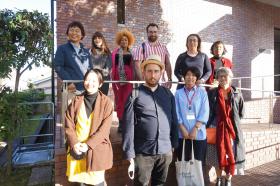 アート・リサーチセンター(以下ARC)は11月4日(金)にアレクサンドラ・コビルスキ氏率いる「J-InnovaTech」研究プロジェクト・チームを迎え、国際共同研究採択課題「新しい近代京都機械捺染史構築に向けて―近代デザインと産業史をむすぶデジタル・アーカイブを一助として―(代表:上田文)」主催のもと、国際ワークショップを開催しました。(ワークショップは非公開で行われました。)
アート・リサーチセンター(以下ARC)は11月4日(金)にアレクサンドラ・コビルスキ氏率いる「J-InnovaTech」研究プロジェクト・チームを迎え、国際共同研究採択課題「新しい近代京都機械捺染史構築に向けて―近代デザインと産業史をむすぶデジタル・アーカイブを一助として―(代表:上田文)」主催のもと、国際ワークショップを開催しました。(ワークショップは非公開で行われました。)コビルスキ氏は、フランス国立科学研究センター(CNRS)所属の研究員であり、フランス国立社会科学高等研究院「中国・韓国・日本」研究所(CNRS/EHESS/Université de Paris)で日本研究センターの所長を務められています。
現在、コビルスキ氏は、2018年にヨーロッパ研究評議会(ERC)スターティンググラント助成金を獲得した「J-InnovaTech ユリイカの向こうへ:日本の第一産業化(1800年-1885年)」プロジェクトを遂行されています。
本ワークショップでは、ARC副センター長の鈴木桂子教授が司会を務めました。 双方の研究者が19世紀京都の繊維産業の歴史の考え方について意見交換し、今後の研究協力について話し合いました。
イベント情報
開催日 :11月4日(金)15:20〜19:00
開催場所:立命館大学衣笠キャンパス 創思館 SO405主催:国際共同研究採択課題「新しい近代京都機械捺染史構築に向けて―近代デザインと産業史をむすぶデジタル・アーカイブを一助として―」
共催:立命館大学アート・リサーチセンター 文部科学省 国際共同利用・共同研究拠点「日本文化資源デジタル・アーカイブ国際共同研究拠点(ARC-iJAC)」 With the establishment of the International Joint Digital Archiving Center for Japanese Art and Culture (ARC-iJAC) in 2019, the Art Research Center strives to push the internationalization of research activities that transcend disciplines and geographic boundaries.
With the establishment of the International Joint Digital Archiving Center for Japanese Art and Culture (ARC-iJAC) in 2019, the Art Research Center strives to push the internationalization of research activities that transcend disciplines and geographic boundaries.NEWS
 The ARC received the Digital Archive Japan Award (DAJ) 2022 on Aug.25
The ARC received the Digital Archive Japan Award (DAJ) 2022 on Aug.25
The ARC is enormously honored to be one of the first recipients of the Digital Archive Japan Award (DAJ).
The DAJ is an award system newly established by Japan Search, a platform operated by the National Diet Library, for aggregating metadata of digital resources. Regarding this award, Prof. Ryo Akama, Director of the ARC, expressed:
Regarding this award, Prof. Ryo Akama, Director of the ARC, expressed:
"The ARC faculty would like to take this award as an opportunity to further respond to the needs of users worldwide by disseminating information on cultural resources in Japan which go beyond areas such as ukiyo-e, early Japanese books, and banzuke-related contents."
As a curator at the Prince Chichibu Memorial Sports Museum, Murakami is leading a joint research project with the ARC on digital-archiving the extensive collection of sports materials of the museum in cooperation with the ARC. 
She also reflects on her internship experience at UC Berkeley, facilitated by the ARC, while she was a graduate student at Ritsumeikan University. >>Read full interview. 
Prof. Hosoi took on a pioneering role when he founded the Game Archive Project (GAP)--a collaboration between Nintendo, Kyoto Prefecture, and Ritsumeikan University. 
In the interview, Prof. Hosoi reflects on the early days of his game research and discusses the social impact of games, the acceleration of the metaverse amid COVID-19, and future directions for game research. 
 On August 21, 2022, ARC faculty member Prof. Satoshi Tanaka (College of Information Science and Engineering, RU) presented the research outcomes of his project on the ultra-high-quality see-through 3D visualization of Taimadera Temple at a roundtable event, held as part of its special exhibition 'Researching Cultural Heritages' at the Nara Prefecture Historical and Artistic Culture Complex. >>Read more.
On August 21, 2022, ARC faculty member Prof. Satoshi Tanaka (College of Information Science and Engineering, RU) presented the research outcomes of his project on the ultra-high-quality see-through 3D visualization of Taimadera Temple at a roundtable event, held as part of its special exhibition 'Researching Cultural Heritages' at the Nara Prefecture Historical and Artistic Culture Complex. >>Read more.
Mikiharu Takeuchi took home top honors at the award ceremony for the 11th Young Scholar Award sponsored by ESRI, a major geographic information system (GIS) software company based in the US. 
Takeuchi is a doctoral student at the Graduate School of Letters and is supervised by Prof. Keiji Yano, Deputy Director of the ARC. >>Read more. [Video available] Prof. Koichi Hosoi & Prof. Keiji Yano Presented Research Activities at the WEB 3.0/ Metaverse Study Meeting
The WEB 3.0/ Metaverse Study Meeting was held by Kyoto Chiesangyo Sozonomori on August 29, 2022.
Prof. Hosoi (College of Image Arts and Sciences, RU) held a keynote speech on the next-generation internet world as seen through the XR/ metaverse. Prof. Yano (College of Letters, RU) presented his research with the case study on the construction of Virtual Kyoto using GIS. >> Watch full video.


Upcoming Events
November 16 (Wed), 2022, 18:00-19:30
110th International ARC Seminar
Speaker: Dr. Ellis TINIOS (Honorary Lecturer in History, School of History, University of Leeds, UK)
Topic: 'After native drawings': the books that introduced nishiki-e and ehon to Western audiences: Narrative of the Earl of Elgin's Mission to China and Japan (1859) and Japanese Fragments (1861).November 19 (Sat) - December 19 (Mon)Special Exhibition
Kamigata no Chūshingura Ukiyo-e
Ako City Museum of History
(co-organized by Art Research Center, Ritsumeikan University)
Details: http://www.ako-rekishi.jp/guide-planning/




Previous issues:
Summer 2022, Spring 2022, Winter 2021, Autumn 2021, Summer 2021, Spring 2021, Winter 2020, Autumn 2020, Summer 2020, Spring 2020view this email in your browser Copyright © 2021 Art Research Center, Ritsumeikan University. All rights reserved.
Our mailing address is:
56-1 Toji-in Kitamachi, Kita-ku, Kyoto 603-8577 JAPAN
Want to change how you receive these emails?
You can update your preferences or unsubscribe from this list. 10
11
12
13
14
15
16
17
18
19
20
10
11
12
13
14
15
16
17
18
19
20



